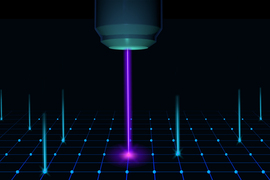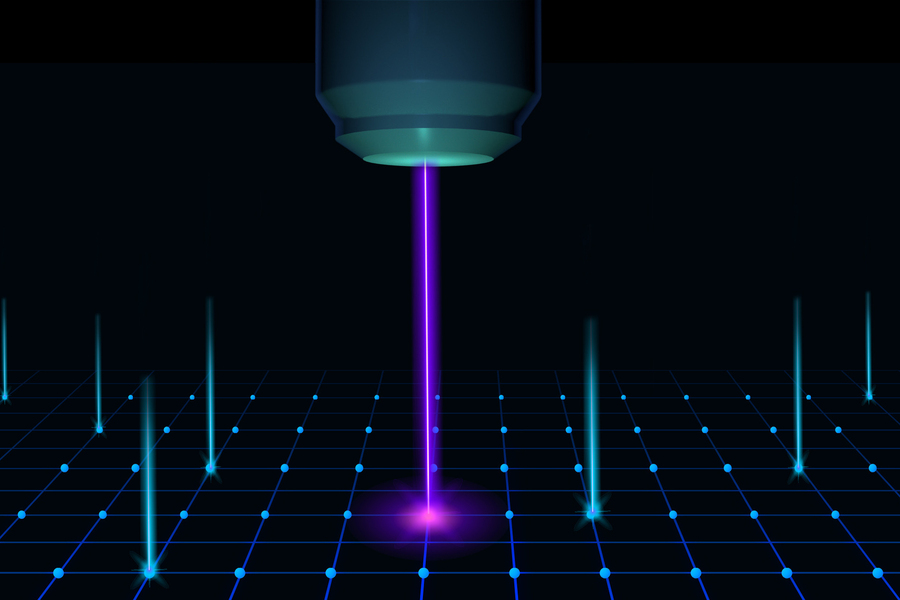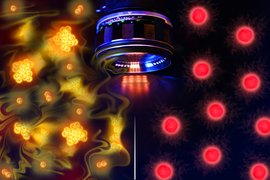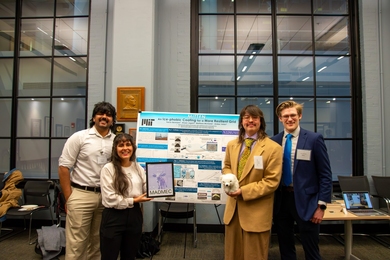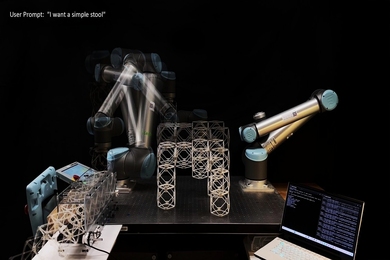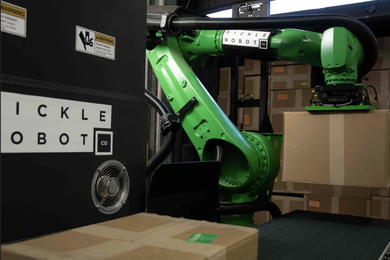Audio
If you think of a single atom as a grain of sand, then a wavelength of visible light — which is a thousand times larger than the atom’s width — is comparable to an ocean wave. The light wave can dwarf an atom, missing it entirely as it passes by. This gulf in size has long made it impossible for scientists to see and resolve individual atoms using optical microscopes alone.
Only recently have scientists found ways to break this “diffraction limit,” to see features that are smaller than the wavelength of light. With new techniques known as super-resolution microscopy, scientists can see down to the scale of a single molecule.
And yet, individual atoms have still been too small for optical microscopes — which are much simpler and less expensive than super-resolution techniques — to distinguish, until now.
In an open-access paper appearing today in Nature Communications, MIT scientists present a new computational method that enables optical microscopes to resolve individual atoms and zero in on their exact locations in a crystal structure.
The team’s new “discrete grid imaging technique,” or DIGIT, is a computational imaging approach that scientists can apply to optical data to calculate the most probable location of individual atoms based on a very important clue: the material’s known atomic configuration. As long as scientists have an idea of what a material’s physical atomic layout should be, they can use this layout as a sort of map to determine where specific atoms or features must be located.
“It’s like you know there’s a seating chart,” says lead author Yuqin “Sophia” Duan, a graduate student in MIT’s Department of Electrical Engineering and Computer Science (EECS). “Previous methods could tell you what section an atom is in. But now we can take this seating chart as prior knowledge, and can pinpoint exactly which seat the atom is in.”
With DIGIT, the team can now pinpoint individual atoms with a resolution of 0.178 angstroms. (One angstrom is one-tenth of a nanometer, which is less than half the width of a single atom). The technique enables optical microscopes to localize atomic-scale features in any material that has a known atomic pattern, such as crystalline materials or certain proteins with repeating molecular chains.
The team says the method could help guide the design of quantum devices, which often require placing individual atoms precisely within a crystal. Beyond quantum technologies, DIGIT can also provide new insights into how defects and impurities shape the behavior of advanced materials — from semiconductors to superconductors.
Duan’s co-authors at MIT are Qiushi Gu, Hanfeng Wang, Yong Hu, Kevin Chen, Matthew Trusheim, and EECS Professor Dirk Englund.
Grid support
Scientists can image features smaller than a nanometer, and sometimes as small as a single atom, but not with optical microscopes. In these cases, they use transmission or scanning electron microscopes, which send high-energy beams of electrons into a sample to generate an image based on the pattern in which the electrons scatter. These electron-based methods produce highly detailed, near-atomic-scale images, but they require imaging in a vacuum and at high energies, and only work in ultrathin, synthetic, or solid-state materials. Electron-based imaging methods are too harsh for more delicate living specimens.
In contrast, optical microscopes work at lower energies, in ambient conditions, and are safe to apply to biological samples. But they cannot discern features past the diffraction limit. Essentially, a microscope is unable to see features that are smaller than half the wavelength of visible light (about 200 to 300 nanometers) that a microscope sends in to probe a sample. Atoms, then, have long eluded optical microscopes.
In 2014, however, the Nobel Prize in Chemistry was awarded to developers of a technique to overcome the diffraction limit. Super-resolution microscopy works by shining laser light on a sample at a specific frequency that is known to resonate with a feature of interest, such as a certain molecule. When that molecule resonates, it effectively announces its presence in the material. With this optical manipulation, scientists can visualize features as small as 10 nanometers, on the scale of a single molecule.
Duan and Englund looked to resolve even smaller features by combining super-resolution techniques with statistical analysis and knowledge of materials that has often been overlooked.
“One thing that gets ignored in imaging optical systems is the physical configuration of your system,” Duan says. “For example, if you want to visualize defects in a diamond system, these defects can only be at certain positions, since they have to follow the grid of the atomic diamond structure. In proteins, there are some structures that grow in an organized grid, and their location must be somewhere along that physical grid.”
The researchers suspected that if they had a reasonably accurate map of a material’s atomic structure (imagine the ball-and-stick models of molecules in a chemistry classroom), they might use such maps as a template and try out many different orientations and rotation angles to find the closest match to whatever features are initially visualized using super-resolution microscopy.
“No one has ever done this before, to include the physical constraints or system information into the resolution technique,” Duan says.
Blurriness, collapsed
To test their idea, the researchers worked with a sample of diamond — a crystal whose microstructure is well-understood and resembles an organized grid, or lattice, of repeating carbon atoms. The researchers blindly knocked out some carbon atoms in the lattice and replaced them with silicon atoms using facilities at MIT.nano. Their goal was to identify and determine the precise locations of the errant silicon atoms.
To do so, they first used established techniques of super-resolution microscopy to probe the diamond sample, using lasers set to specific wavelengths at frequencies known to resonate with the silicon atoms but not the carbon atoms. With this technique, researchers produced images that depicted the silicon atoms, but only as a uniform blur.
The team then applied DIGIT to further resolve the picture. Knowing that diamond in general has a grid-like configuration of carbon atoms, the researchers took this configuration as a map, or seating chart of sorts, and assumed that any silicon atoms that took the place of a carbon atom must sit within the grid, which has a known spacing between atoms.
“Because the silicon atoms are substituting carbon atoms in the lattice, that means they must obey some integer multiple of the atomic spacing of the crystal lattice, separating any two silicon atoms,” Englund says. “That prior knowledge makes the localization different than if you add a purely amorphous material.”
The researchers essentially simulated many possibilities of orientations and rotation angles of the diamond lattice, superimposed on the blurry image of atoms that the super-resolution microscopy technique produced.
“The trick is that, in certain materials, atoms aren’t spread out randomly — they sit on a grid inside a crystal,” Duan explains. “We used that prior knowledge to sharpen the microscope’s picture. Once we factored in that ‘atomic grid,’ the blurriness collapsed, and we could pinpoint exact positions.”
In the end, they found the technique could pinpoint the location of individual silicon atoms within the diamond lattice, with a precision of 0.178 angstroms — the sharpest resolution of any optical-based imaging technique. The team has made the DIGIT code available on GitHub for anyone to apply to their optical measurements, provided their sample of interest has a well-understood atomic structure. Then, they hope that scientists will start to see much finer and detailed features and processes using light.
“It’s a big step — it takes optical microscopes into the realm of atomic scale, something people thought only electron microscopes or X-rays could do,” Duan says. “That opens up a whole new way of studying materials and biology.”
